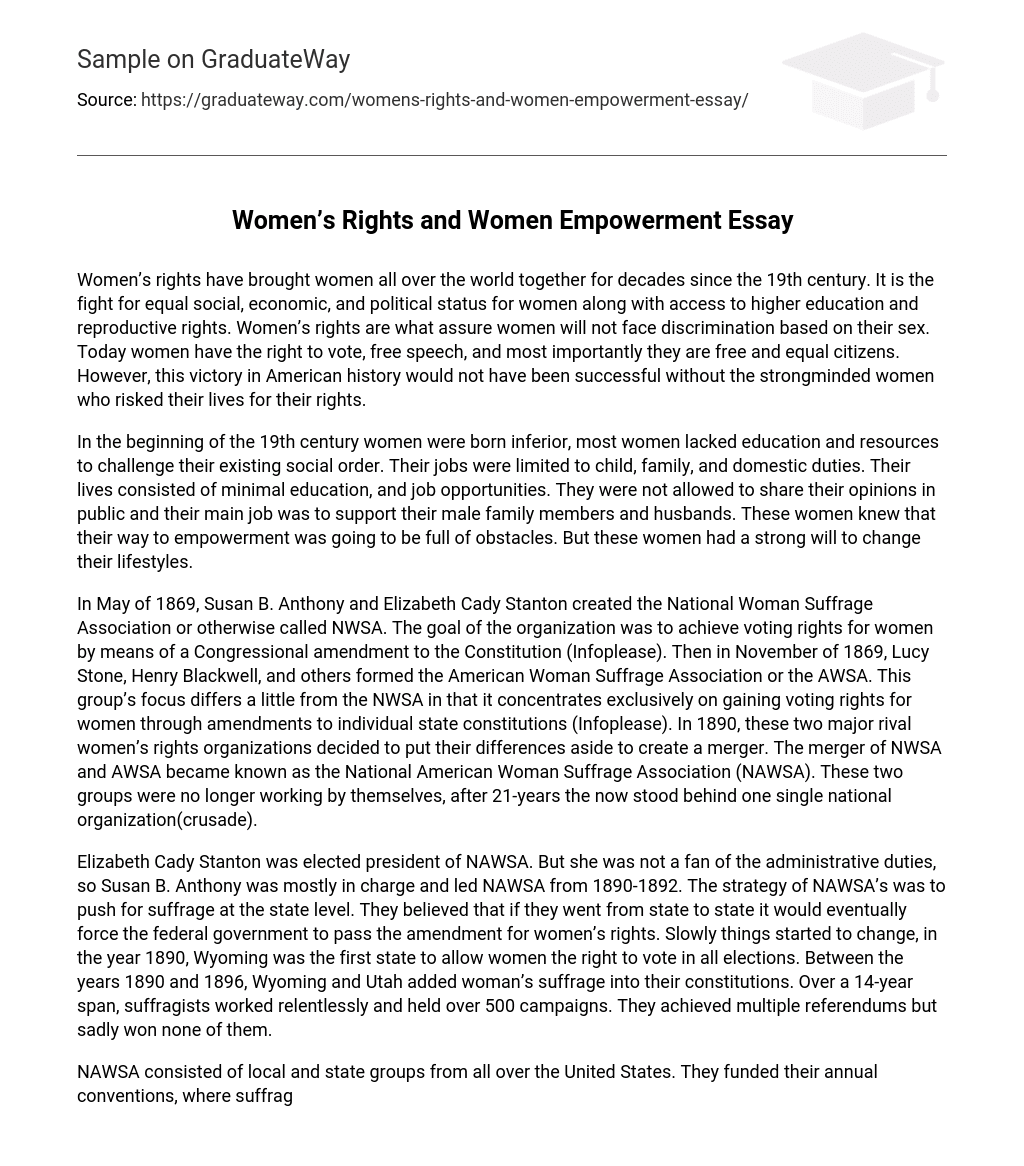Women’s rights have brought women all over the world together for decades since the 19th century. It is the fight for equal social, economic, and political status for women along with access to higher education and reproductive rights. Women’s rights are what assure women will not face discrimination based on their sex. Today women have the right to vote, free speech, and most importantly they are free and equal citizens. However, this victory in American history would not have been successful without the strongminded women who risked their lives for their rights.
In the beginning of the 19th century women were born inferior, most women lacked education and resources to challenge their existing social order. Their jobs were limited to child, family, and domestic duties. Their lives consisted of minimal education, and job opportunities. They were not allowed to share their opinions in public and their main job was to support their male family members and husbands. These women knew that their way to empowerment was going to be full of obstacles. But these women had a strong will to change their lifestyles.
In May of 1869, Susan B. Anthony and Elizabeth Cady Stanton created the National Woman Suffrage Association or otherwise called NWSA. The goal of the organization was to achieve voting rights for women by means of a Congressional amendment to the Constitution (Infoplease). Then in November of 1869, Lucy Stone, Henry Blackwell, and others formed the American Woman Suffrage Association or the AWSA. This group’s focus differs a little from the NWSA in that it concentrates exclusively on gaining voting rights for women through amendments to individual state constitutions (Infoplease). In 1890, these two major rival women’s rights organizations decided to put their differences aside to create a merger. The merger of NWSA and AWSA became known as the National American Woman Suffrage Association (NAWSA). These two groups were no longer working by themselves, after 21-years the now stood behind one single national organization(crusade).
Elizabeth Cady Stanton was elected president of NAWSA. But she was not a fan of the administrative duties, so Susan B. Anthony was mostly in charge and led NAWSA from 1890-1892. The strategy of NAWSA’s was to push for suffrage at the state level. They believed that if they went from state to state it would eventually force the federal government to pass the amendment for women’s rights. Slowly things started to change, in the year 1890, Wyoming was the first state to allow women the right to vote in all elections. Between the years 1890 and 1896, Wyoming and Utah added woman’s suffrage into their constitutions. Over a 14-year span, suffragists worked relentlessly and held over 500 campaigns. They achieved multiple referendums but sadly won none of them.
NAWSA consisted of local and state groups from all over the United States. They funded their annual conventions, where suffragists met to talk campaigning, by paying dues to the organization. Women like Rachel Foster Avery spread the word by newsletters with the latest news on women’s suffrage. NAWSA had many connections with the local and national press committees, in turn the press wrote articles supporting the movement and published them in newspapers around the United States.
The next task on NAWSA’s agenda concentrated on colleting votes for women’s rights and drafting fresh new members(crusade). The year is 1900 and every state has passed a legislation that mirrored the New York’s Married Women’s Property Act. This act granted married women more control over their belongings and wages. From 1900 to 1904 NAWSA initiated what was known as the “society plan” to recruit college-educated, privileged, and politically influential members. The group wanted to prepare for the suffrage fight by broadening their education to strengthen their knowledge on the issue at hand. (brittanica).
The circumstances started to change in 1910, when NAWSA organized aggressive state campaigns that did not only reach out to the middle-class, college-educated, privileged, and politicians but also included immigrants and working-class women. Between 1910 and 1912, six states grant women the right to vote with more states to follow. The suffrage movement did not stop there, simultaneously they were gathering more support from national reform groups. In 1915, NAWSA’s ‘Winning Plan’ was proposed, which was based on the principle that each state that gave wo the National Woman’s Party (NWP) was instrumental in raising public awareness of the women’s suffrage campaign.





